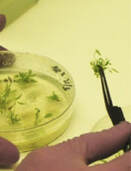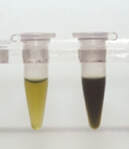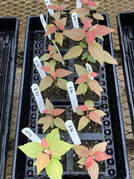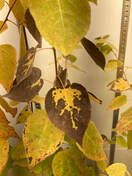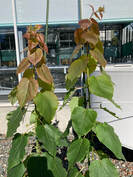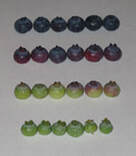|
Biochemistry, Molecular Biology, and Ecology of Defensive Phenolic Metabolism in Trees Trees are challenged by many stresses in their natural environment, yet thrive because of their biochemical adaptations. Many plants use phenolic secondary metabolites such as tannins to defend themselves and adapt to stressful conditions. In our work, we use Populus (poplars and aspens) as a model system, since these trees contain large amounts of phenolics. We also study other phenolic-producing forest species, such as red alder and salal. Our ultimate aim is to understand i) how trees synthesize phenolic metabolites, ii) how this is regulated, and iii) how phenolics affect tree resilience. To approach these questions, we apply techniques ranging from genome analysis to ecophysiology and chemical ecology. We rely on extensively on molecular tools including qPCR and RNAseq, enzyme assays and protein biochemistry, phytochemical analysis by HPLC and LC-MS, as well analysis of transgenic poplar plants. We have extensive expertise in plant transformation and have generated many lines of overexpressor-, RNAi-, and CRISPR-transgenic poplars to study gene function. As part of our effort to characterize important poplar genes and their effects, we often collaborate with insect physiologists, chemists, and ecologists. Current work focusses on two major groups of poplar secondary metabolites: i) proanthocyanidins (condensed tannins), and ii) poplar phenolic glycosides known as salicinoids. Proanthocyanidins are polymeric flavonoids and have many interesting biological activities. They are induced in poplar by different stresses, and we have studied several MYB transcriptional regulators which control the proanthocyanidin pathway. Understanding what controls synthesis of proanthocyanidins has broad implications, since these chemicals are found in many food plants (grains, fruit and berries) and are important in the maintenance of human health. Salicinoids are salicyl alcohol-based phenolic glycosides that are found only in willow and poplar trees. They are the major defenses against insect pests and also have medicinal relevance. Despite their importance their biosynthesis is not known, but recently we identified the first confirmed enzyme of this pathway (Fellenberg et al., 2019). Current Research Projects Transcriptional regulation of proanthocyanidin biosynthesis in poplar Following our original identification of the proanthocyanidin regulator MYB134, we have now characterized several other MYB activators and MYB repressors that all contribute proanthocyanidin and flavonoid synthesis in leaves. We have developed a model of a transcriptional network, composed of positive and negative regulators. Currently, our aim is to study regulation and function of the proanthocyanidin pathway in roots, and we are working to generate knock-out mutants using CRISPR/Cas in transgenic poplars. In collaborative projects with scientists in Sweden, we are testing the importance of proanthocyanidins in mycorrhizal interactions (David Ma, post-doctoral fellow, 2019; Yalin Liu, MSc 2022). Functional analysis of candidate genes for salicinoid biosynthesis Using extensive co-expression analysis, we have identified several novel enzymes for the salicinoid pathway. We recently demonstrated using CRISPR/Cas in poplar that a glucosyl transferase, UGT71L1, is absolutely required for this pathway. We are now using recombinant protein production and enzyme assays, as well as in transgenic poplar plants, to test additional candidate genes. By applying gene editing technology to generate transgenic knock-out poplar plants, we plan to test the functions of additional candidate genes (Harley Gordon, PhD 2023) Physiological functions of proanthocyanidins as in planta antioxidants The proanthocyanidins have excellent antioxidant activity in extracts, leading to the hypothesis that these compounds can protect poplars plants against oxidative stress. We have now tested this idea using MYB134-overexpressing transgenic poplars, and exposing them to drought, UV-B and the herbicide methyl viologen in order to cause oxidative stress. Our findings suggest that high proanthocyanidin concentrations are indeed beneficial in reducing oxidative stress in trees, and that proanthocyanidin-rich plants have enhanced tolerance to these stresses. We are now planning to test if high proanthocyanidin concentrations could be important in reducing oxidative stress during leaf senescence in poplar (Gerry Gourlay, PhD 2019). Biochemistry of poplar leaf bud resin Poplar leaf buds secrete a sticky resin that contains many interesting and bioactive phenolic secondary metabolites such as flavanones, dihydroflavonols, and various benzoate and hydroxycinnamate esters. In a new project, we are investigating the biochemistry of this resin, with the aim of identifying the enzymes for the biosynthesis of specific flavonoids and their modification (Eerik-Mikael Piirtola, PhD candidate). Previous Research Projects Purification and biological activities of oregonin, a diarylheptanoid phenolic from red alder trees Red Alder contains high amounts of a diarylheptanoid phenolic known as oregonin, which is responsible for the red coloration of the bark. We have evidence to suggest it is also an important defensive metabolite in alder. This secondary metabolite is now being purified from native Red alder trees, in order to conduct insect and pathogen bioassays for studying its biological activity (Carmen Lea, MSc 2020). Characterization of proanthocyanidins (tannins) and phenolics in barley and malt Malted barley is a key ingredient for brewing industry, and is a source proanthocyanidins (condensed tannins) in beer. These have important sensory and biochemical properties. As a new collaborative project with a local brewery, we are profiling the phenolics and tannins in malted barley. The ultimate goal is to understand how the malting process affects the release of these chemicals into the wort and beer (Dr. Christin Fellenberg, post-doctoral fellow; Dr. Lynn Yip, Research Associate). Biosynthesis of proanthocyanidins (tannins) in blueberry and salal berry fruit Flavonoids and proanthocyanidins in the human diet are important for preventing cardiovascular disease. Based on our knowledge of proanthocyanidin synthesis and its regulation in poplar, we have identified the corresponding genes in apple and blueberry. These fruits are major sources of health-promoting flavonoids in the North American diet, and important crops in British Columbia. Recently, we completed a study of salalberry fruit, a traditionally used berry crop which contain incredibly high concentrations of proanthocyanidins and other phenolics (Andrew Ferguson, undergraduate student; Mike Zifkin, MSc 2012; Andreas Gesell, post-doctoral fellow, 2014). Functions of poplar BAHD acyl transferases The diversity of poplar phenolic glycosides suggests the involvement of BAHD acyl transferases. We have identified several acyl transferases, which may contribute to poplar defense or phenolic synthesis. These genes are being cloned into in E. coli for functional analysis, and we plan to test their biological activities in transgenic poplar plants (Russ Chedgy, PhD 2015). Functions of poplar flavonoid glycosyl transferases During our studies of defense responses in poplar, we have identified flavonoid glycosyl transferases, which may contribute to poplar defense or proanthocyanidin synthesis. These genes are being expressed in bacteria in order to test the enzymological properties of the encoded proteins, and are also being modulated in transgenic poplar plants (Vasko Veljanovski, PhD 2012). Analysis and expression of polyphenol oxidases in poplar Polyphenol oxidases (PPOs) are common plant enzymes with a diversity of function, including defense against pests and pathogens. We used genome databases to study the entire PPO gene family in poplar and other plants. We have discovered a novel type of PPO, and have shown that it is unique in being localized to the vacuole (Lan Tran, MSc 2011). Proteomics of poplar phloem Phloem sap contains at least 200 distinct proteins, but few have been characterized. We have used a proteomics approach to identify proteins in poplar phloem. In collaboration with the UVic Proteomics Centre, we have identified almost 100 such proteins using a combination of MALDI-TOF and tandem mass spectrometry. Our aim is to better understand the role of phloem proteins in plants, many of which are annotated as plant defense proteins (Nicole Dafoe, PhD 2009). Gene expression profiling in herbivore defense Using genomics and other tools for gene expression profiling, we identified more than 100 genes strongly upregulated by herbivory. We have studied global patterns of regulation of these genes in response to wounding and to insect elicitors, substances found in insect regurgitant. We work to understand the role that many of these induced genes play in plant defense and how the corresponding proteins work as defensive agents (Ian Major, PhD 2007). |

